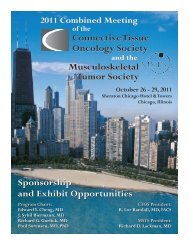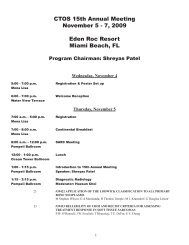207 Poster Session 2 - Connective Tissue Oncology Society
207 Poster Session 2 - Connective Tissue Oncology Society
207 Poster Session 2 - Connective Tissue Oncology Society
Create successful ePaper yourself
Turn your PDF publications into a flip-book with our unique Google optimized e-Paper software.
Scientific <strong>Poster</strong>s – <strong>Poster</strong> <strong>Session</strong> 2spine (96.9%), pelvis (100%), and extremities (97.9%). Inspinal lesions, 5 out of 8 failures were categorized as inadequatematerials containing a blood clot, although 3 ofthem were finally diagnosed as an osteosarcoma.Conclusion: The success rate of needle biopsy with ICEin bone and soft tissue lesions at our institute was higherthan in past reports, even in spinal lesions. Confirming aspecimen by ICE would improve the accuracy of needlebiopsy.<strong>Poster</strong> #176WHOLE-BODY PET/MR IN SOFT TISSUESARCOMA (STS) PATIENTSStephan Richter 1 ; Ivan Platzek 2 ; Bettina Beuthien-Baumann 3 ;Jörg van den Hoff 4 ; Michael Laniado 2 ; Jörg Kotzerke 3 ;Frank Kroschinsky 1 ; Gerhard Ehninger 1 ; Markus Schuler 11Medizinische Klinik und Poliklinik I, University HospitalCarl Gustav Carus, Dresden, Germany; 2 Department ofRadiology, University of Technology, Dresden, Germany;3Department of Nuclear Medicine, University of Technology,Dresden, Germany; 4 PET Centre, Institute of Radiopharmacy,Helmholtz-Zentrum Dresden-Rossendorf, Dresden, GermanyObjective: PET/MR (positron emission tomography/magnetic resonance imaging) is a new whole-body hybridimaging technique that combines metabolic and cross-sectionaldiagnostic imaging. To date the only available clinicaldata are drawn from feasibility studies in small series ofhead and neck cancers and intracranial tumors. Imagingby combined PET and computed tomography (PET/CT)has been investigated in STS for biopsy guidance, responseassessment and grading.Methods: This exploratory analysis evaluated the outcomesof PET/MRI in 21 patients with STS in differenttreatment settings: (a) neoadjuvant setting, (b) metabolicdrivenlocal therapy in metastatic sarcoma, and (c) palliativetreatment. For examination we used an IngenuityPET/MR system (Philips Healthcare). It combines a 3-TeslaMRI and a PET scanner.Results: PET/MR shows a high contrast imaging withoutsignificant artifacts or distortions.(a) Four patients with high-risk sarcoma (3 rhabdo, 1 pleomorphic)completed the planned neoadjuvant therapy.Change in tumor size did not correlat with pathologicresponse, whereas surgical outcome was well predictedby metabolic changes. Due to this finding the preplannedcourse of chemotherapy for one patient was changed.(b) To prolong disease stabilization of 3 patients with aremnant metabolic activity in a single spot they underwenta surgical resection of a single metastatic lesion or had alocal radiotherapeutic approach.c) In 3 patients with stable disease after first-line treatmentwith combination of anthracyline and ifosfamide persistingmetabolic activity indicated a switch to another alternative2nd line regime. Trabectedin as 2nd line therapy decreasedmetabolic activity that finally resulted in a tumor regression.Conclusion: To our knowledge this is the first report onpatients with STS examined with whole-body-PET/MR.PET/MR is feasible in STS and may provide valuable informationin treatment, monitoring and prognosis of patientswith STS. This technique may help to choose accurate andon-time treatment option without unnecessary time delay.Further prospective studies to evaluate PET/MR in STSare warranted.<strong>Poster</strong> #177ENABLING DISEASE PROGNOSIS WITH MASSSPECTROMETRY - TOWARDS PREDICTINGMETASTASES OF SOFT TISSUE SARCOMASErin Seeley 2 ; Richard M. Caprioli 2 ; Ginger E. Holt 11Vanderbilt, Nashville, TN, USA; 2 Mass Spectrometry Center,Vanderbilt Medical Center, Nashville, TN, USAObjective: Classical histology cannot differentiate tumorswith high metastatic potential (HMP) from those with lowmetastatic potential (LMP). We sought to compare themolecular signatures of HMP and LMP to determine ifmetastatic behavior could be predicted. We also present thefirst comparison of matched pairs of formalin fixed paraffinembedded and snap frozen tissue samples to determine ifthey yield the same results in a clinical study.Methods: Medical records were queried to determinemetastasis status of patients who had undergone surgicaltumor ressection. Protein mass spectral profiles wereacquired in linear positive mode on a Bruker AutoflexSpeed mass spectrometer. On-tissue tryptic digestion wascarried out by first applying trypsin prior to CHCA usingthe Portrait Statistical analysis using a Genetic Algorithmclassification was achieved using ClinProTools (Bruker)and additional analysis was carried out using the statisticalanalysis of microarrays plugin for Excel.Results: A total of 26 HMP and 24 LMP sarcoma weresubjected to analysis using ClinProTools. Spectra werebaseline corrected, normalized, and aligned to commonpeaks. Peak boundaries were manually determined. AGenetic Algorithm classification model was created by usinga Leave 20% Out cross validation. The m/z values thatcomprise the model and their relative weights. The modelwas then applied to the entire data set to determine overallspectral classification accuracy. Finally, the spectra fromeach patient were evaluated and a 2/3 cutoff was used to260






